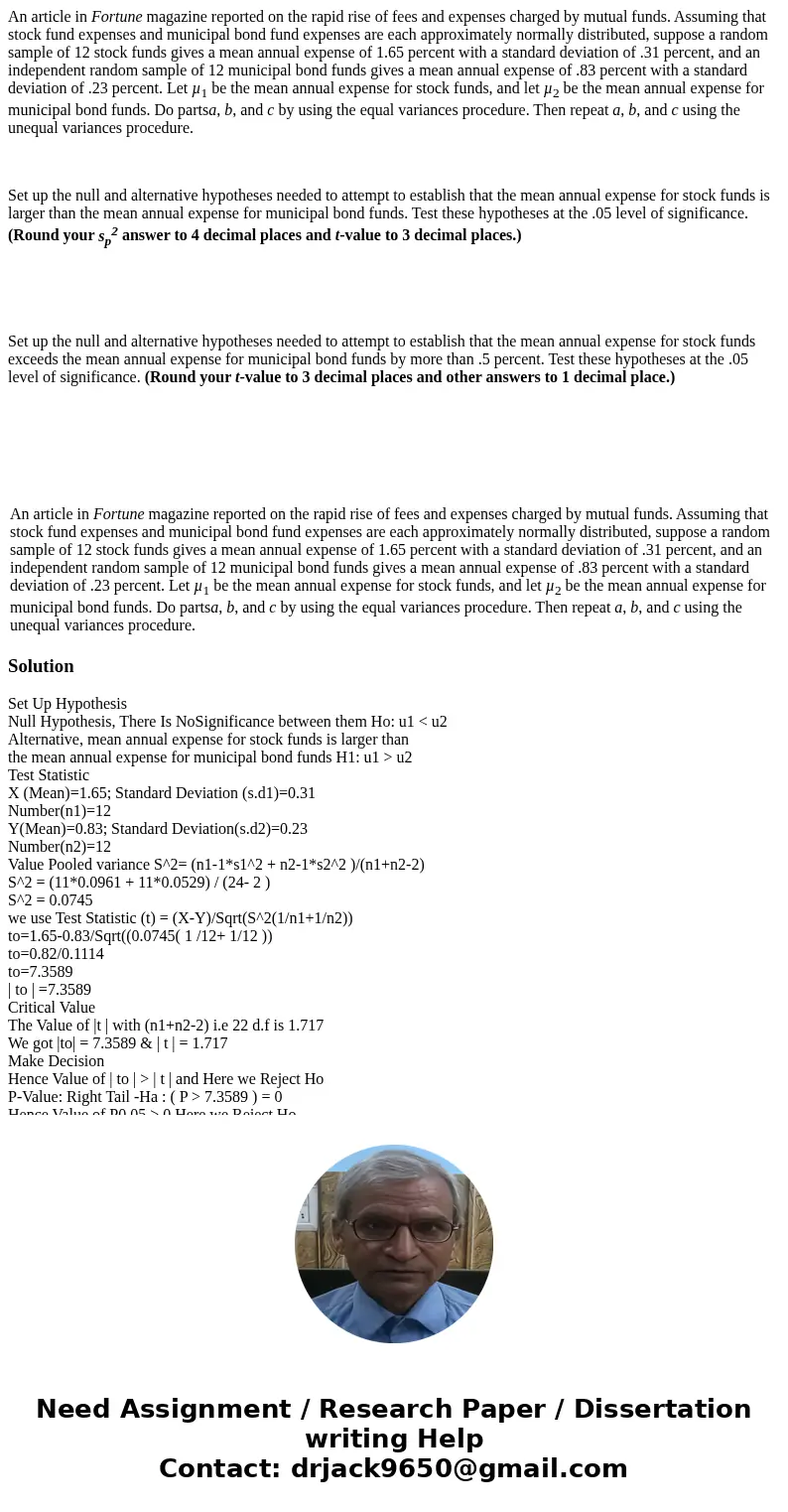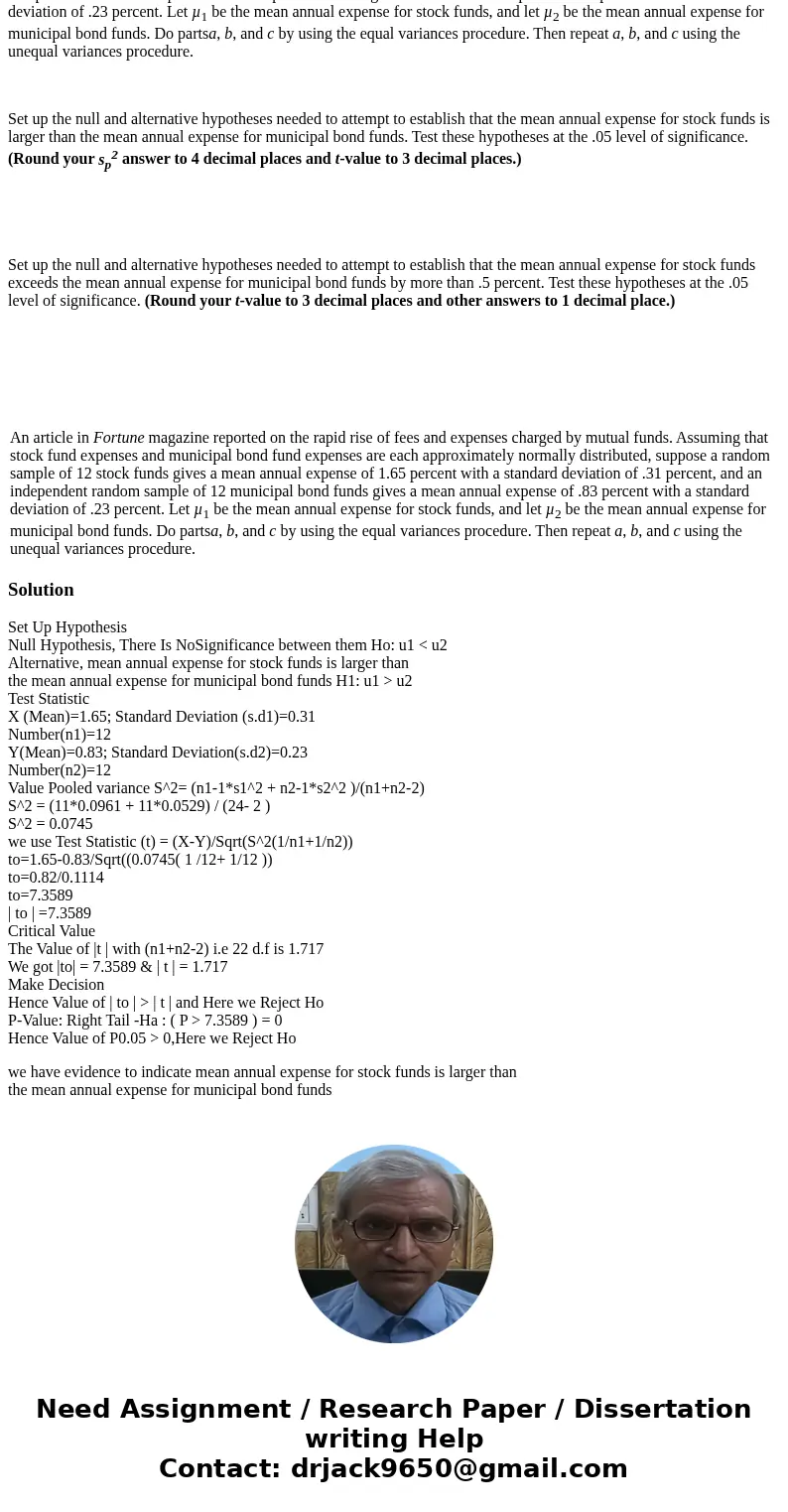An article in Fortune magazine reported on the rapid rise of
An article in Fortune magazine reported on the rapid rise of fees and expenses charged by mutual funds. Assuming that stock fund expenses and municipal bond fund expenses are each approximately normally distributed, suppose a random sample of 12 stock funds gives a mean annual expense of 1.65 percent with a standard deviation of .31 percent, and an independent random sample of 12 municipal bond funds gives a mean annual expense of .83 percent with a standard deviation of .23 percent. Let µ1 be the mean annual expense for stock funds, and let µ2 be the mean annual expense for municipal bond funds. Do partsa, b, and c by using the equal variances procedure. Then repeat a, b, and c using the unequal variances procedure.
Set up the null and alternative hypotheses needed to attempt to establish that the mean annual expense for stock funds is larger than the mean annual expense for municipal bond funds. Test these hypotheses at the .05 level of significance. (Round your sp2 answer to 4 decimal places and t-value to 3 decimal places.)
Set up the null and alternative hypotheses needed to attempt to establish that the mean annual expense for stock funds exceeds the mean annual expense for municipal bond funds by more than .5 percent. Test these hypotheses at the .05 level of significance. (Round your t-value to 3 decimal places and other answers to 1 decimal place.)
| An article in Fortune magazine reported on the rapid rise of fees and expenses charged by mutual funds. Assuming that stock fund expenses and municipal bond fund expenses are each approximately normally distributed, suppose a random sample of 12 stock funds gives a mean annual expense of 1.65 percent with a standard deviation of .31 percent, and an independent random sample of 12 municipal bond funds gives a mean annual expense of .83 percent with a standard deviation of .23 percent. Let µ1 be the mean annual expense for stock funds, and let µ2 be the mean annual expense for municipal bond funds. Do partsa, b, and c by using the equal variances procedure. Then repeat a, b, and c using the unequal variances procedure. |
Solution
Set Up Hypothesis
Null Hypothesis, There Is NoSignificance between them Ho: u1 < u2
Alternative, mean annual expense for stock funds is larger than
the mean annual expense for municipal bond funds H1: u1 > u2
Test Statistic
X (Mean)=1.65; Standard Deviation (s.d1)=0.31
Number(n1)=12
Y(Mean)=0.83; Standard Deviation(s.d2)=0.23
Number(n2)=12
Value Pooled variance S^2= (n1-1*s1^2 + n2-1*s2^2 )/(n1+n2-2)
S^2 = (11*0.0961 + 11*0.0529) / (24- 2 )
S^2 = 0.0745
we use Test Statistic (t) = (X-Y)/Sqrt(S^2(1/n1+1/n2))
to=1.65-0.83/Sqrt((0.0745( 1 /12+ 1/12 ))
to=0.82/0.1114
to=7.3589
| to | =7.3589
Critical Value
The Value of |t | with (n1+n2-2) i.e 22 d.f is 1.717
We got |to| = 7.3589 & | t | = 1.717
Make Decision
Hence Value of | to | > | t | and Here we Reject Ho
P-Value: Right Tail -Ha : ( P > 7.3589 ) = 0
Hence Value of P0.05 > 0,Here we Reject Ho
we have evidence to indicate mean annual expense for stock funds is larger than
the mean annual expense for municipal bond funds


 Homework Sourse
Homework Sourse